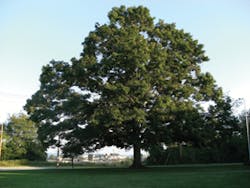Leaves: The Fulcrum on Which the Water Balance Rests
The hydrologic cycle is an interwoven network of dynamic equilibria of water in all its physical states driven by the Sun. The incoming solar radiation is all the energy available to cycle water through the air, land, and plant life by technology of the green leaf. An exploratory evaluation of the natural state and energy balance of the landscape sets up a framework for design, management, and operation of a comprehensive stormwater system in an urbanized landscape. The evaluation focused on natural vegetative cover as dictated by native soils, topography, and geographic latitude.
Sun: The Pulsing Power Plant
The Sun emits about 1,368 W/m2 (Willson et al. 1981) of solar radiation toward the Earth in any given moment. The energy arrives packaged in daily doses varying with time of day, time of year, and location on the planet. Some radiation (10%) is scattered, and some (18%) is absorbed as it travels through the atmosphere (Hu and White 1983). On balance, half of the year is night, and half of the year is day. Solar energy as the driving force behind a hydrologic cycle is distributed as heat of vaporization, or transferred as a temperature increase into the environment. The net shortwave solar radiation is re-emitted as sensible heat (H), converted to soil heat (G) or storage (S), or is consumed by evaporation as latent heat (LE).
Rn = S + G + H + LE
In the annual cycle, the heat storage is negligible, and the soil heat is small in forested landscapes compared to the sensible and latent heat components of the budget. On the Cumberland Plateau, near the 36th parallel, the National Oceanic and Atmospheric Administration (NOAA) and the National Aeronautics and Space Administration (NASA) report the annual incoming radiation to be about 5.4 GJ/m2 with an average of 20 MJ/m2 per day during the growing season (Figure 1).
Soil: The Shaded Storage Sponge
The native soil in Cumberland County, TN, is uncompacted and well to moderately drained, with an average depth of 30 inches (762 mm) underlain by massive sandstone bedrock. From the Cumberland County soil survey, the available water supply of 0.15 cm/cm and volumetric water content at 15 bars of 11% for the soil equates to a capacity to store up to 7 inches (198 mm) of water in the soil profile. The Soil Survey of Cumberland County (NRCS 2006) provides information on type of vegetation for each soil map unit. Figure 2 shows the vegetation cover derived from the soil survey information for area of interest in Cumberland County. On undisturbed soil in the county, we will most likely find a closed-canopy oak-pine forest. With 50/50 split between the oak and the pine (Eyre 1980), the forest hydrologically functions year round and moderates well the extremes of saturation and drought. The soil is well shaded and experiences minimal heat extremes.
Rain: The Remarkable Recirculating Refrigerant
The Natural Resources Conservation Service reports precipitation in Crossville, Cumberland County, TN, averages around 58 in (1,449 mm) annually. In the most simplified form, the hydrologic cycle distributes precipitation (P) to storage (S), discharge (Q), and evapotranspiration (ET).
P = S + Q + ET
The National Weather Service reports little over 32 inches (813 mm) of free water surface evaporation annually for Cumberland County. Looking at annual averages (P = 58 inches, ET = 32 inches) and assuming full storage (S = 7 inches) in the soil, 33% of the annual precipitation feeds the streams. The rest is cycled through soil storage into the atmosphere by the leaves and needles of the forest. To move 32 inches (813 mm) of water (at average annual ambient temperature of 13°C) up into the air, 2.0 GJ/m2 (37 % of annual budget) of solar energy is used for the phase change of water from liquid to vapor. The energy is later released during condensation when clouds and raindrops form. The remaining 3.4 GJ/m2 of solar energy is transferred as sensible heat into the surrounding environment, and less than 1% is used for photosynthesis (KravÄÃk et al. 2007): manufacture of more biomass.
Plants: The Perfected Primary Protection
Plants are well adapted to the precipitation and climate patterns in a given location. Plants evaporate water by an active process called transpiration. Transpiration has similar endpoints as evaporation: saturated boundary layer near the evaporative surface and high water deficit. The plants access soil water storage through roots and transport each molecule to the leaf surface by physical and chemical processes driven by the moisture potential gradients. Brady and Weil (2002) report the moisture potential gradient from soil (-50 kPa) to root (-70 kPa) is 20 kPa. From root (-70 kPa) to canopy branches (-85 kPa) the gradient is 15 kPa. From the branches (-85 kPa) to the leaf surface (-500 kPa) the gradient is over 400 kPa. From leaf (-500 kPa) to the atmosphere (-20,000 kPa) the gradient is 15,000 kPa. The limits of transpiration are reached when roots cannot supply enough moisture to the leaves or when surrounding air reaches 100% relative humidity.
The actual evapotranspiration rates are highly variable. Table 1 provides evapotranspiration values for various vegetation covers derived from the literature applicable to the Cumberland Plateau in Tennessee. (The entire literature review is included as a table here.)
On an average summer day, with an average summer supply of moisture, the oak-pine forest on the Cumberland Plateau consumes 40% of the solar radiation for evaporative cooling, and 40% is radiated out by the forest canopy as heat. The humidity of the canopy air is typically the limiting factor of evaporation. The understory and the ground are shaded and do not experience an appreciable heat flux. The forest creates a well-air-conditioned microclimate that conserves water, shades the ground, and provides cooling.
Asphalt Parking Lot: The Barren Urban Desert
Leaving the forest behind and facing the view ahead, the scenario of the quintessential asphalt parking lot comes to a sharp focus. We all experienced the magnitude of the sensible heat flux emitted from the parking lot on a summer day or even at night. Taking the average dose of the solar radiation, 5 to 10% of the radiation reflects from the black asphalt (35% from light concrete) into the atmosphere. The rest, at the rate of 0.19 to 0.22 cal/g/°C, is stored as heat in the pavement itself (Wilson 2011), heating the air around it through a long wave radiation. Any cooling by evaporation or transpiration is dependent on water availability. The detention ponds are typically designed to be dry. It takes the same amount of energy to evaporate the liquid water as it does to transpire it through leaves; however, there is no water storage for the stunted sparse shrubs to access on the conventional parking lot. All is flat, sealed, and hot. As in the heat balance, where all incoming radiation turns to sensible heat, the water balance also tips, and virtually all of precipitation turns to runoff, leaving the flat and sealed urban desert barren and dry.
House and Lawn: The American Dream
With the parking lot in our rear view mirror, we head for the house. Let us take a closer look at our next destination. The house in the suburbs sits in a yard with trimmed lawn, sealed asphalt driveway, and a few ornamental trees. Half of the lot is sealed surface (asphalt driveway and shingle roof); the other half is managed Bermuda turf. Although the lawn does not provide any shading or much of microclimate, the Bermuda lawn is reported by the Interstate Technology and Regulatory Council to evapotranspire up to 0.5 inch (14 mm) of water per day (2009). The turf acts as a high output evaporative blanket, sinking virtually the entire daily dose of summer solar radiation (31 MJ/m2) into phase change of water. The average evapotranspiration of 0.25 inch (6 mm) is used for average balance calculations. Assuming that rainwater is used for lawn irrigation during the growing season, the annual water balance for the turf shows that 26% of the annual precipitation leaves as runoff. Weighing in the sealed surface at 50/50 ratio, the annual runoff from the home site is 60% with the rainwater collection and irrigation system in use. The total sensible heat released from the home site is 50% of the average summer radiation. The originally forested site released about 33% of the annual precipitation as runoff and 40% of the average summer radiation as sensible heat above the canopy.
Foliage: The Familiar Fastigiated Fulcrum
As we look at the water balance and the heat flux balance, evapotranspiration connected to water storage is the fulcrum on which the balance rests. Stormwater management, engineered or natural, is already a part of the site design dictionary. Ornamental vegetation and managed turf, currently in the form of landscaping plans, become evapotranspirative structures and features when connected to rainwater storage. Combined with wetlands, biofilters, and infiltration areas, evapotranspiration design adds hydrologic function and tilts the balance closer to the original hydrology of the landscape.
New technology comes in the form of designed evapotranspirative wetlands, rainwater irrigated turf blankets, transpiration groves, and even individual trees as sculpted solitaries. Leaves of all plants are the self-contained evaporative cooling fins integrated into the filtered water storage through water-extracting osmotic systems powered by solar energy. Table 2 lists some of the most efficient evapotranspirators. They come self-assembled, require minimal maintenance, and are capable of growth, reproduction, and self-repair.
References Brady, N.C., and R.R. Weil. 2002. The Nature and Properties of Soils, 13th ed. Upper Saddle River, NJ: Prentice Hall. Eyre, F. H., Ed. 1980. Forest Cover Types of the United States and Canada. Washington DC: Society of American Foresters. Hu, C. and R. M. White. 1983. Solar Cells: From Basic to Advanced Systems. New York: McGraw-Hill. Interstate Technology 7 Regulatory Council. 2009. Phytotechnology Technical and Regulatory Guidance and Decision Trees, Revised. Washington DC. Kravčík, M., J. Pokorný, J. Kohutiár, M. Kováč, and E. Tóth. 2007. Water for the Recovery of the Climate – A New Water Paradigm. Available at http://waterparadigm.org/indexen.php?web=./home/homeen.html. NASA solar data available at http://eosweb.larc.nasa.gov/sse. National Oceanic and Atmospheric Administration. 1982. Evaporation Atlas for the Contiguous 48 United States. NOAA Technical Report NWS33. Washington DC: US Department of Commerce. Natural Resources Conservation Service (NRCS). 2006. The Soil Survey of Cumberland County, Tennessee, 2006. United states Department of Agriculture. Available at http://websoilsurvey.nrcs.usda.gov and http://soildatamart.nrcs.usda.gov/manuscripts/TN035/0/TNCumberland6_06Web.pdf. NOAA solar data available at http://www.ncdc.noaa.gov/crn. NRCS climate data available at http://www.wcc.nrcs.usda.gov/ftpref/support/climate/taps/tn/47035.txt. Willson, R. C., S. Gulkis, M. Janssen, H. S. Hudson, and G. A. Chapman. 1981. “Observations of Solar Irradiance Variability.” Science 211(4483), 700–702. Wilson, W. G. 2011. Constructed Climates: A Primer on Urban Environments. Chicago: University of Chicago Press.


